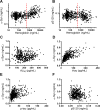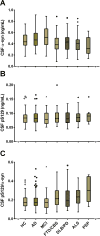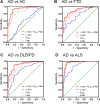Cerebrospinal fluid α-synuclein contributes to the differential diagnosis of Alzheimer's disease
- PMID: 29604263
- PMCID: PMC6097943
- DOI: 10.1016/j.jalz.2018.02.015
Cerebrospinal fluid α-synuclein contributes to the differential diagnosis of Alzheimer's disease
Abstract
Introduction: The ability of Alzheimer's disease (AD) cerebrospinal fluid (CSF) biomarkers (amyloid β peptide 1-42, total tau, and phosphorylated tau) to discriminate AD from related disorders is limited. Biomarkers for other concomitant pathologies (e.g., CSF α-synuclein [α-syn] for Lewy body pathology) may be needed to further improve the differential diagnosis.
Methods: CSF total α-syn, phosphorylated α-syn at Ser129, and AD CSF biomarkers were evaluated with Luminex immunoassays in 367 participants, followed by validation in 74 different neuropathologically confirmed cases.
Results: CSF total α-syn, when combined with amyloid β peptide 1-42 and either total tau or phosphorylated tau, improved the differential diagnosis of AD versus frontotemporal dementia, Lewy body disorders, or other neurological disorders. The diagnostic accuracy of the combined models attained clinical relevance (area under curve ∼0.9) and was largely validated in neuropathologically confirmed cases.
Discussion: Combining CSF biomarkers representing AD and Lewy body pathologies may have clinical value in the differential diagnosis of AD.
Keywords: Alzheimer's disease; Biomarkers; Cerebrospinal fluid; Differential diagnosis; α-synuclein.
Copyright © 2018 the Alzheimer's Association. Published by Elsevier Inc. All rights reserved.
Conflict of interest statement
Figures




Similar articles
-
Differential role of CSF fatty acid binding protein 3, α-synuclein, and Alzheimer's disease core biomarkers in Lewy body disorders and Alzheimer's dementia.Alzheimers Res Ther. 2017 Jul 28;9(1):52. doi: 10.1186/s13195-017-0276-4. Alzheimers Res Ther. 2017. PMID: 28750675 Free PMC article.
-
The value of cerebrospinal fluid α-synuclein and the tau/α-synuclein ratio for diagnosis of neurodegenerative disorders with Lewy pathology.Eur J Neurol. 2020 Jan;27(1):43-50. doi: 10.1111/ene.14032. Epub 2019 Jul 24. Eur J Neurol. 2020. PMID: 31293044
-
α-Synuclein and tau concentrations in cerebrospinal fluid of patients presenting with parkinsonism: a cohort study.Lancet Neurol. 2011 Mar;10(3):230-40. doi: 10.1016/S1474-4422(11)70014-X. Lancet Neurol. 2011. PMID: 21317042
-
Diagnostic value of cerebrospinal fluid alpha-synuclein in dementia with Lewy body.Geriatr Psychol Neuropsychiatr Vieil. 2018 Sep 1;16(3):305-310. doi: 10.1684/pnv.2018.0750. Geriatr Psychol Neuropsychiatr Vieil. 2018. PMID: 30168437 Review. English.
-
Diagnostic value of Alzheimer's biomarkers in cerebrospinal fluid in dementia with Lewy body.Geriatr Psychol Neuropsychiatr Vieil. 2018 Jun 1;16(2):174-180. doi: 10.1684/pnv.2018.0731. Geriatr Psychol Neuropsychiatr Vieil. 2018. PMID: 29877185 Review. English.
Cited by
-
Cerebrospinal Fluid, Imaging, and Physiological Biomarkers in Dementia With Lewy Bodies.Am J Alzheimers Dis Other Demen. 2019 Nov-Dec;34(7-8):421-432. doi: 10.1177/1533317519869700. Epub 2019 Aug 18. Am J Alzheimers Dis Other Demen. 2019. PMID: 31422676 Free PMC article. Review.
-
Unlocking early detection of Alzheimer's disease: The emerging role of nanomaterial-based optical sensors.J Food Drug Anal. 2024 Sep 13;32(3):296-324. doi: 10.38212/2224-6614.3520. J Food Drug Anal. 2024. PMID: 39636776 Free PMC article. Review.
-
High Levels of β-Amyloid, Tau, and Phospho-Tau in Red Blood Cells as Biomarkers of Neuropathology in Senescence-Accelerated Mouse.Oxid Med Cell Longev. 2019 Jun 9;2019:5030475. doi: 10.1155/2019/5030475. eCollection 2019. Oxid Med Cell Longev. 2019. PMID: 31281579 Free PMC article.
-
Validity of CSF alpha-synuclein to predict psychosis in prodromal Alzheimer's disease.Front Neurol. 2023 May 24;14:1124145. doi: 10.3389/fneur.2023.1124145. eCollection 2023. Front Neurol. 2023. PMID: 37292130 Free PMC article.
-
Alpha-synuclein: a pathological factor with Aβ and tau and biomarker in Alzheimer's disease.Alzheimers Res Ther. 2022 Dec 31;14(1):201. doi: 10.1186/s13195-022-01150-0. Alzheimers Res Ther. 2022. PMID: 36587215 Free PMC article. Review.
References
-
- McKhann GM, Knopman DS, Chertkow H, Hyman BT, Jack CR, Jr, Kawas CH, et al. The diagnosis of dementia due to Alzheimer's disease: recommendations from the National Institute on Aging-Alzheimer's Association workgroups on diagnostic guidelines for Alzheimer's disease. Alzheimers Dement. 2011;7:263–9. - PMC - PubMed
-
- Blennow K, Hampel H, Weiner M, Zetterberg H. Cerebrospinal fluid and plasma biomarkers in Alzheimer disease. Nat Rev Neurol. 2010;6:131–44. - PubMed
-
- Mattsson N, Lonneborg A, Boccardi M, Blennow K, Hansson O. Clinical validity of cerebrospinal fluid Abeta42, tau, and phospho-tau as biomarkers for Alzheimer's disease in the context of a structured 5-phase development framework. Neurobiol Aging. 2017;52:196–213. - PubMed
-
- Ewers M, Mattsson N, Minthon L, Molinuevo JL, Antonell A, Popp J, et al. CSF biomarkers for the differential diagnosis of Alzheimer's disease: A large-scale international multicenter study. Alzheimers Dement. 2015;11:1306–15. - PubMed
Publication types
MeSH terms
Substances
Grants and funding
- P30 AG010124/AG/NIA NIH HHS/United States
- P01 AG017586/AG/NIA NIH HHS/United States
- R56 AG057417/AG/NIA NIH HHS/United States
- U01 NS091272/NS/NINDS NIH HHS/United States
- P50 NS053488/NS/NINDS NIH HHS/United States
- R21 NS104511/NS/NINDS NIH HHS/United States
- R21 NS085425/NS/NINDS NIH HHS/United States
- U01 NS082137/NS/NINDS NIH HHS/United States
- R21 MH118160/MH/NIMH NIH HHS/United States
- U01 NS097056/NS/NINDS NIH HHS/United States
- R01 AG056711/AG/NIA NIH HHS/United States
- K23 NS088341/NS/NINDS NIH HHS/United States
LinkOut - more resources
Full Text Sources
Other Literature Sources
Medical
Miscellaneous

